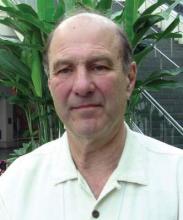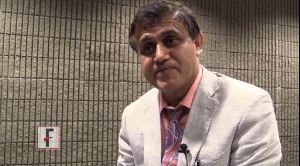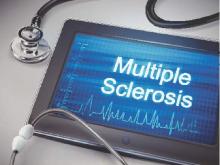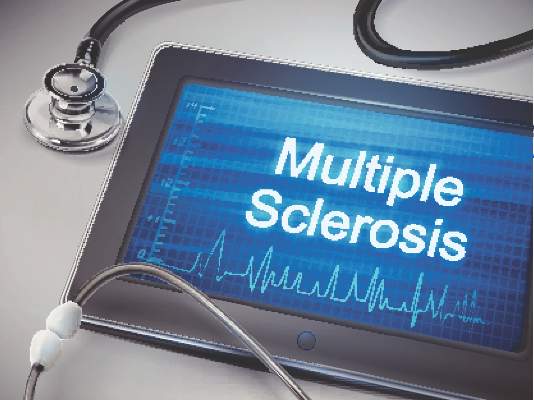User login
Targeting vagal activity could improve breast cancer survival
ATLANTA – Vagal activity predicts survival in patients with metastatic or recurrent breast cancer, a study showed.
The findings are intriguing, given that vagal activity is modifiable, according to Dr. David Spiegel, Willson Professor of Psychiatry and Behavioral Sciences and director of the center on stress and health at Stanford (Calif.) University.
The study, conducted by Dr. Spiegel and his colleagues, is one of several that together are beginning to elucidate the connections among sleep, stress, and vagal tone, and the effects these factors have on cancer outcomes. For example, in one earlier study of metastatic breast cancer patients, the group demonstrated that good sleep efficiency predicted longer survival (Sleep. 2014 May 1;37[5]:837-42).
“There’s something about sleep that we think has an effect on disease progression,” Dr. Spiegel said at the annual meeting of the American Psychiatric Association.
In another study, the team showed that breast cancer patients who slept better at night had better vagal tone the following morning.
“We all kind of know that a problem that has been keeping you from getting to sleep or worrying you a lot the night before suddenly seems more soluble in the morning after you’ve had a good night’s sleep. You’re better able to self-soothe in the morning,” he said, noting the importance of this evidence that “sleep improves vagal tone.”
Heart rate variability is a good measure of vagal tone, vagal activity, and the ability to self-soothe, he explained, noting that heart rate variability also predicts longer survival with cardiac disease; it seems to reduce the risk of fatal arrhythmias, and also predicts recovery from myocardial infarction.
Others have suggested that it might have an effect on cancer, and there seems to be a link between vagal activity and inflammatory processes, Dr. Spiegel said.
“There is reason to think that poor heart rate variability might be associated with cancer progression as well, and that’s what we wanted to study in a group of metastatic cancer patients,” he said.
Dr. Spiegel and his colleagues measured high-frequency heart rate variability (HF-HRV), which appears to be the best measure of parasympathetic tone, has been associated with longer survival in humans and animals, and is related to immune system functioning.
“We hypothesized that higher heart rate variability would predict longer survival in patients with MRBC [metastatic or recurrent breast cancer],” he said.
In 87 patients with metastases to bone, skin, or viscera who underwent a variety of stress measures, including a 5-minute resting baseline electrocardiogram, 43 had higher HF-HRV, and 44 had lower HF-HRV. Higher baseline HF-HRV did, indeed, predict significantly longer survival (hazard ratio, 0.75).
“The main hypothesis was confirmed – that patients with better vagal tone, higher high-frequency heart rate variability had significantly longer survival over the ensuing 7 years, compared with the patients who had poorer heart rate variability, poorer vagal tone,” he said (Psychosom Med. 2015;77[4]:346-55).
Visceral metastasis status and baseline heart rate both were related to HF-HRV and survival, and the combination of HF-HRV and heart rate further improved survival prediction (HR, 0.64), he noted.
“This is basically coactivation of higher parasympathetic and lower sympathetic activity related to longer survival,” he explained.
Reconstructive surgery, the presence of visceral metastases, and sleep efficiency each were found to be associated with heart rate variability; thus several analyses were conducted “to try to disentangle these relationships and determine what the major variables were that predicted survival,” Dr. Spiegel said.
“It turns out that heart rate variability and visceral metastases were significantly related, and heart rate variability did not predict survival,” he said, explaining that those with visceral metastases (and therefore, cancer with a much poorer prognosis) died sooner, but heart rate variability didn’t make much of a difference. “Where we saw the heart rate variability effect was among those with better prognosis.”
A combination measure of high heart rate variability (“a pretty pure measure of vagal activity, not sympathetic activity”) and low heart rate (“more driven by the sympathetic adrenal-medullary system”) is an even stronger predictor of overall survival, he said.
This suggests that autonomic nervous system variables play a strong role in predicting overall cancer survival, Dr. Spiegel said, noting that depression was not a confounder.
“This is important, because we have, in other studies, found that depression is associated with lower heart rate variability, as you might expect,” he said. In fact, depression has been found to predict shorter survival in cancer patients over a period of 10 years. In an earlier study, cancer patients with worsening depression in the first year died sooner than those with depression that improved during the first year (J Clin Oncol. 2011;29[4]:413-20).
“The median survival difference was about 2 years, so this is not a trivial difference in overall survival,” he said, stressing that the finding is based on more chronic and severe depression.
Other studies have demonstrated relationships between circadian rhythm disruption and cancer survival. In one such study involving patients with metastatic colorectal cancer, circadian rhythm/rest activity cycle (more activity during the day, more rest at night) was associated with better quality of life and predicted survival.
“This has been shown now in several cancers, and it’s clear that a combination of higher activity and better sleep predict longer survival with different kinds of cancers,” Dr. Spiegel said, explaining that a hallmark of a healthy hypothalamic-pituitary-adrenal axis is good diurnal variation of cortisol with high levels in the morning and declining levels throughout the day.
Women with metastatic breast cancer and poorer survival tended to have flat or increasing levels of cortisol throughout the day, he said, adding that the same was true in a study of patients with lung cancer, and that there is evidence that those among them with flatter, more abnormal cortisol patterns throughout the day also have shorter survival.
Animal studies suggest that cortisol might directly suppress the activity of tumor suppressor genes, he explained, noting that there is also increasing evidence of autonomic dysregulation effects on inflammatory processes associated with tumor growth.
“Some basic research on this in animal models shows that if you block adrenergic arousal, you can block the growth of blood vessels from tumors. This has led some people to look at the use of antiadrenergic drugs like the beta-blocker propranolol, and it turned out – to everyone’s surprise – that breast cancer patients who happened to be on beta-blockers for hypertension actually lived longer than those who didn’t,” he said.
This adds to the growing evidence that dysregulation in the sympathetic and parasympathetic systems have effects on survival, he said.
A look at another factor related to sleep disruption – bedtime misalignment – showed that patients who adhere to their preferred sleep pattern, and who are therefore sleeping better, had a difference in disease-free interval; those whose bedtime was misaligned had a shorter time between diagnosis and disease recurrence (Chronobiol Int. 2014 Mar 31[2]214-21).
“Disease-free interval is a very strong predictor of ultimate overall survival, so there seems to be another relationship here between circadian disruption and disease progression in breast cancer,” Dr. Spiegel said.
Taken together, these findings demonstrate a strong association between vagal activity and survival in patients with metastatic or recurrent breast cancer, extending the known predictive window of HF-HRV beyond palliative care to cancer, Dr. Spiegel said.
“Vagal activity can be altered through behavioral, pharmacological, and surgical interventions and thus may be a promising target for increasing survival in patients with metastatic cancer,” he said.
Dr. Spiegel’s studies were funded by the National Cancer Institute and the National Institute on Aging.
ATLANTA – Vagal activity predicts survival in patients with metastatic or recurrent breast cancer, a study showed.
The findings are intriguing, given that vagal activity is modifiable, according to Dr. David Spiegel, Willson Professor of Psychiatry and Behavioral Sciences and director of the center on stress and health at Stanford (Calif.) University.
The study, conducted by Dr. Spiegel and his colleagues, is one of several that together are beginning to elucidate the connections among sleep, stress, and vagal tone, and the effects these factors have on cancer outcomes. For example, in one earlier study of metastatic breast cancer patients, the group demonstrated that good sleep efficiency predicted longer survival (Sleep. 2014 May 1;37[5]:837-42).
“There’s something about sleep that we think has an effect on disease progression,” Dr. Spiegel said at the annual meeting of the American Psychiatric Association.
In another study, the team showed that breast cancer patients who slept better at night had better vagal tone the following morning.
“We all kind of know that a problem that has been keeping you from getting to sleep or worrying you a lot the night before suddenly seems more soluble in the morning after you’ve had a good night’s sleep. You’re better able to self-soothe in the morning,” he said, noting the importance of this evidence that “sleep improves vagal tone.”
Heart rate variability is a good measure of vagal tone, vagal activity, and the ability to self-soothe, he explained, noting that heart rate variability also predicts longer survival with cardiac disease; it seems to reduce the risk of fatal arrhythmias, and also predicts recovery from myocardial infarction.
Others have suggested that it might have an effect on cancer, and there seems to be a link between vagal activity and inflammatory processes, Dr. Spiegel said.
“There is reason to think that poor heart rate variability might be associated with cancer progression as well, and that’s what we wanted to study in a group of metastatic cancer patients,” he said.
Dr. Spiegel and his colleagues measured high-frequency heart rate variability (HF-HRV), which appears to be the best measure of parasympathetic tone, has been associated with longer survival in humans and animals, and is related to immune system functioning.
“We hypothesized that higher heart rate variability would predict longer survival in patients with MRBC [metastatic or recurrent breast cancer],” he said.
In 87 patients with metastases to bone, skin, or viscera who underwent a variety of stress measures, including a 5-minute resting baseline electrocardiogram, 43 had higher HF-HRV, and 44 had lower HF-HRV. Higher baseline HF-HRV did, indeed, predict significantly longer survival (hazard ratio, 0.75).
“The main hypothesis was confirmed – that patients with better vagal tone, higher high-frequency heart rate variability had significantly longer survival over the ensuing 7 years, compared with the patients who had poorer heart rate variability, poorer vagal tone,” he said (Psychosom Med. 2015;77[4]:346-55).
Visceral metastasis status and baseline heart rate both were related to HF-HRV and survival, and the combination of HF-HRV and heart rate further improved survival prediction (HR, 0.64), he noted.
“This is basically coactivation of higher parasympathetic and lower sympathetic activity related to longer survival,” he explained.
Reconstructive surgery, the presence of visceral metastases, and sleep efficiency each were found to be associated with heart rate variability; thus several analyses were conducted “to try to disentangle these relationships and determine what the major variables were that predicted survival,” Dr. Spiegel said.
“It turns out that heart rate variability and visceral metastases were significantly related, and heart rate variability did not predict survival,” he said, explaining that those with visceral metastases (and therefore, cancer with a much poorer prognosis) died sooner, but heart rate variability didn’t make much of a difference. “Where we saw the heart rate variability effect was among those with better prognosis.”
A combination measure of high heart rate variability (“a pretty pure measure of vagal activity, not sympathetic activity”) and low heart rate (“more driven by the sympathetic adrenal-medullary system”) is an even stronger predictor of overall survival, he said.
This suggests that autonomic nervous system variables play a strong role in predicting overall cancer survival, Dr. Spiegel said, noting that depression was not a confounder.
“This is important, because we have, in other studies, found that depression is associated with lower heart rate variability, as you might expect,” he said. In fact, depression has been found to predict shorter survival in cancer patients over a period of 10 years. In an earlier study, cancer patients with worsening depression in the first year died sooner than those with depression that improved during the first year (J Clin Oncol. 2011;29[4]:413-20).
“The median survival difference was about 2 years, so this is not a trivial difference in overall survival,” he said, stressing that the finding is based on more chronic and severe depression.
Other studies have demonstrated relationships between circadian rhythm disruption and cancer survival. In one such study involving patients with metastatic colorectal cancer, circadian rhythm/rest activity cycle (more activity during the day, more rest at night) was associated with better quality of life and predicted survival.
“This has been shown now in several cancers, and it’s clear that a combination of higher activity and better sleep predict longer survival with different kinds of cancers,” Dr. Spiegel said, explaining that a hallmark of a healthy hypothalamic-pituitary-adrenal axis is good diurnal variation of cortisol with high levels in the morning and declining levels throughout the day.
Women with metastatic breast cancer and poorer survival tended to have flat or increasing levels of cortisol throughout the day, he said, adding that the same was true in a study of patients with lung cancer, and that there is evidence that those among them with flatter, more abnormal cortisol patterns throughout the day also have shorter survival.
Animal studies suggest that cortisol might directly suppress the activity of tumor suppressor genes, he explained, noting that there is also increasing evidence of autonomic dysregulation effects on inflammatory processes associated with tumor growth.
“Some basic research on this in animal models shows that if you block adrenergic arousal, you can block the growth of blood vessels from tumors. This has led some people to look at the use of antiadrenergic drugs like the beta-blocker propranolol, and it turned out – to everyone’s surprise – that breast cancer patients who happened to be on beta-blockers for hypertension actually lived longer than those who didn’t,” he said.
This adds to the growing evidence that dysregulation in the sympathetic and parasympathetic systems have effects on survival, he said.
A look at another factor related to sleep disruption – bedtime misalignment – showed that patients who adhere to their preferred sleep pattern, and who are therefore sleeping better, had a difference in disease-free interval; those whose bedtime was misaligned had a shorter time between diagnosis and disease recurrence (Chronobiol Int. 2014 Mar 31[2]214-21).
“Disease-free interval is a very strong predictor of ultimate overall survival, so there seems to be another relationship here between circadian disruption and disease progression in breast cancer,” Dr. Spiegel said.
Taken together, these findings demonstrate a strong association between vagal activity and survival in patients with metastatic or recurrent breast cancer, extending the known predictive window of HF-HRV beyond palliative care to cancer, Dr. Spiegel said.
“Vagal activity can be altered through behavioral, pharmacological, and surgical interventions and thus may be a promising target for increasing survival in patients with metastatic cancer,” he said.
Dr. Spiegel’s studies were funded by the National Cancer Institute and the National Institute on Aging.
ATLANTA – Vagal activity predicts survival in patients with metastatic or recurrent breast cancer, a study showed.
The findings are intriguing, given that vagal activity is modifiable, according to Dr. David Spiegel, Willson Professor of Psychiatry and Behavioral Sciences and director of the center on stress and health at Stanford (Calif.) University.
The study, conducted by Dr. Spiegel and his colleagues, is one of several that together are beginning to elucidate the connections among sleep, stress, and vagal tone, and the effects these factors have on cancer outcomes. For example, in one earlier study of metastatic breast cancer patients, the group demonstrated that good sleep efficiency predicted longer survival (Sleep. 2014 May 1;37[5]:837-42).
“There’s something about sleep that we think has an effect on disease progression,” Dr. Spiegel said at the annual meeting of the American Psychiatric Association.
In another study, the team showed that breast cancer patients who slept better at night had better vagal tone the following morning.
“We all kind of know that a problem that has been keeping you from getting to sleep or worrying you a lot the night before suddenly seems more soluble in the morning after you’ve had a good night’s sleep. You’re better able to self-soothe in the morning,” he said, noting the importance of this evidence that “sleep improves vagal tone.”
Heart rate variability is a good measure of vagal tone, vagal activity, and the ability to self-soothe, he explained, noting that heart rate variability also predicts longer survival with cardiac disease; it seems to reduce the risk of fatal arrhythmias, and also predicts recovery from myocardial infarction.
Others have suggested that it might have an effect on cancer, and there seems to be a link between vagal activity and inflammatory processes, Dr. Spiegel said.
“There is reason to think that poor heart rate variability might be associated with cancer progression as well, and that’s what we wanted to study in a group of metastatic cancer patients,” he said.
Dr. Spiegel and his colleagues measured high-frequency heart rate variability (HF-HRV), which appears to be the best measure of parasympathetic tone, has been associated with longer survival in humans and animals, and is related to immune system functioning.
“We hypothesized that higher heart rate variability would predict longer survival in patients with MRBC [metastatic or recurrent breast cancer],” he said.
In 87 patients with metastases to bone, skin, or viscera who underwent a variety of stress measures, including a 5-minute resting baseline electrocardiogram, 43 had higher HF-HRV, and 44 had lower HF-HRV. Higher baseline HF-HRV did, indeed, predict significantly longer survival (hazard ratio, 0.75).
“The main hypothesis was confirmed – that patients with better vagal tone, higher high-frequency heart rate variability had significantly longer survival over the ensuing 7 years, compared with the patients who had poorer heart rate variability, poorer vagal tone,” he said (Psychosom Med. 2015;77[4]:346-55).
Visceral metastasis status and baseline heart rate both were related to HF-HRV and survival, and the combination of HF-HRV and heart rate further improved survival prediction (HR, 0.64), he noted.
“This is basically coactivation of higher parasympathetic and lower sympathetic activity related to longer survival,” he explained.
Reconstructive surgery, the presence of visceral metastases, and sleep efficiency each were found to be associated with heart rate variability; thus several analyses were conducted “to try to disentangle these relationships and determine what the major variables were that predicted survival,” Dr. Spiegel said.
“It turns out that heart rate variability and visceral metastases were significantly related, and heart rate variability did not predict survival,” he said, explaining that those with visceral metastases (and therefore, cancer with a much poorer prognosis) died sooner, but heart rate variability didn’t make much of a difference. “Where we saw the heart rate variability effect was among those with better prognosis.”
A combination measure of high heart rate variability (“a pretty pure measure of vagal activity, not sympathetic activity”) and low heart rate (“more driven by the sympathetic adrenal-medullary system”) is an even stronger predictor of overall survival, he said.
This suggests that autonomic nervous system variables play a strong role in predicting overall cancer survival, Dr. Spiegel said, noting that depression was not a confounder.
“This is important, because we have, in other studies, found that depression is associated with lower heart rate variability, as you might expect,” he said. In fact, depression has been found to predict shorter survival in cancer patients over a period of 10 years. In an earlier study, cancer patients with worsening depression in the first year died sooner than those with depression that improved during the first year (J Clin Oncol. 2011;29[4]:413-20).
“The median survival difference was about 2 years, so this is not a trivial difference in overall survival,” he said, stressing that the finding is based on more chronic and severe depression.
Other studies have demonstrated relationships between circadian rhythm disruption and cancer survival. In one such study involving patients with metastatic colorectal cancer, circadian rhythm/rest activity cycle (more activity during the day, more rest at night) was associated with better quality of life and predicted survival.
“This has been shown now in several cancers, and it’s clear that a combination of higher activity and better sleep predict longer survival with different kinds of cancers,” Dr. Spiegel said, explaining that a hallmark of a healthy hypothalamic-pituitary-adrenal axis is good diurnal variation of cortisol with high levels in the morning and declining levels throughout the day.
Women with metastatic breast cancer and poorer survival tended to have flat or increasing levels of cortisol throughout the day, he said, adding that the same was true in a study of patients with lung cancer, and that there is evidence that those among them with flatter, more abnormal cortisol patterns throughout the day also have shorter survival.
Animal studies suggest that cortisol might directly suppress the activity of tumor suppressor genes, he explained, noting that there is also increasing evidence of autonomic dysregulation effects on inflammatory processes associated with tumor growth.
“Some basic research on this in animal models shows that if you block adrenergic arousal, you can block the growth of blood vessels from tumors. This has led some people to look at the use of antiadrenergic drugs like the beta-blocker propranolol, and it turned out – to everyone’s surprise – that breast cancer patients who happened to be on beta-blockers for hypertension actually lived longer than those who didn’t,” he said.
This adds to the growing evidence that dysregulation in the sympathetic and parasympathetic systems have effects on survival, he said.
A look at another factor related to sleep disruption – bedtime misalignment – showed that patients who adhere to their preferred sleep pattern, and who are therefore sleeping better, had a difference in disease-free interval; those whose bedtime was misaligned had a shorter time between diagnosis and disease recurrence (Chronobiol Int. 2014 Mar 31[2]214-21).
“Disease-free interval is a very strong predictor of ultimate overall survival, so there seems to be another relationship here between circadian disruption and disease progression in breast cancer,” Dr. Spiegel said.
Taken together, these findings demonstrate a strong association between vagal activity and survival in patients with metastatic or recurrent breast cancer, extending the known predictive window of HF-HRV beyond palliative care to cancer, Dr. Spiegel said.
“Vagal activity can be altered through behavioral, pharmacological, and surgical interventions and thus may be a promising target for increasing survival in patients with metastatic cancer,” he said.
Dr. Spiegel’s studies were funded by the National Cancer Institute and the National Institute on Aging.
AT THE APA ANNUAL MEETING
Key clinical point: Vagal activity predicted survival in patients with metastatic or recurrent breast cancer.
Major finding: Higher baseline HF-HRV predicted significantly longer survival (hazard ratio, 0.75).
Data source: A study of 87 patients with metastatic or recurrent breast cancer.
Disclosures: Dr. Spiegel’s studies were funded by the National Cancer Institute and the National Institute on Aging.
VIDEO: Integrated care effective in first-episode psychosis
ATLANTA – Increasingly, data support taking an integrated approach to care in the intervention of first-episode psychosis.
But what are the key components of such treatment?
Dr. Charles Schulz, who initiated an integrated care clinic for first-episode psychosis at the University of Minnesota, Minneapolis, outlined the steps in an integrated care approach.
In an interview at the annual meeting of the American Psychiatric Association, Dr. Schulz reviewed the importance of intervening in the prodromal phase whenever possible, as well as offering cognitive-behavioral and remediation therapies along with medication management.
He also addressed the need for family psychoeducation and group therapy. And Dr. Schulz explained what to do when there might be a differential that manifests with psychiatric presentations that are not psychosis.
Dr. Schulz said he has industry relationships with Forum Pharmaceuticals and Myriad.
The video associated with this article is no longer available on this site. Please view all of our videos on the MDedge YouTube channel
On Twitter @whitneymcknight
ATLANTA – Increasingly, data support taking an integrated approach to care in the intervention of first-episode psychosis.
But what are the key components of such treatment?
Dr. Charles Schulz, who initiated an integrated care clinic for first-episode psychosis at the University of Minnesota, Minneapolis, outlined the steps in an integrated care approach.
In an interview at the annual meeting of the American Psychiatric Association, Dr. Schulz reviewed the importance of intervening in the prodromal phase whenever possible, as well as offering cognitive-behavioral and remediation therapies along with medication management.
He also addressed the need for family psychoeducation and group therapy. And Dr. Schulz explained what to do when there might be a differential that manifests with psychiatric presentations that are not psychosis.
Dr. Schulz said he has industry relationships with Forum Pharmaceuticals and Myriad.
The video associated with this article is no longer available on this site. Please view all of our videos on the MDedge YouTube channel
On Twitter @whitneymcknight
ATLANTA – Increasingly, data support taking an integrated approach to care in the intervention of first-episode psychosis.
But what are the key components of such treatment?
Dr. Charles Schulz, who initiated an integrated care clinic for first-episode psychosis at the University of Minnesota, Minneapolis, outlined the steps in an integrated care approach.
In an interview at the annual meeting of the American Psychiatric Association, Dr. Schulz reviewed the importance of intervening in the prodromal phase whenever possible, as well as offering cognitive-behavioral and remediation therapies along with medication management.
He also addressed the need for family psychoeducation and group therapy. And Dr. Schulz explained what to do when there might be a differential that manifests with psychiatric presentations that are not psychosis.
Dr. Schulz said he has industry relationships with Forum Pharmaceuticals and Myriad.
The video associated with this article is no longer available on this site. Please view all of our videos on the MDedge YouTube channel
On Twitter @whitneymcknight
EXPERT ANALYSIS FROM THE APA ANNUAL MEETING
Study Shines Light on "Invisible Epidemic"
ATLANTA – Early findings from the ongoing Vitamin D and Omega-3 Trial–Depression Endpoint Prevention (VITAL-DEP) study are bringing to light the “invisible epidemic” of alcohol use among older adults.
“Alcohol use in the older population is a growing public health problem, and it’s going to get worse as baby boomers age,” Dr. Grace Chang said during an update on the study at the annual meeting of the American Psychiatric Association. “[The problem] has been described as an invisible epidemic because of the very, very low rates of identification.”
“But this counterculture generation is bringing its alcohol and drug habits into old age,” said Dr. Chang, professor of psychiatry at Harvard Medical School, Boston.
Dr. Chang cited national survey data and statistics in her presentation. Accidental drug overdose death rates tell part of the story; the rates are highest among adults aged 45-60 years, at 18.67 per 100,000, compared with 18.66 in those aged 25-44 years, and 10.52 in those aged 55-74 years, she noted, adding that “it’s a problem just on the verge of exploding.”
In a subset of 1,045 subjects from among the more than 18,000 enrolled in the large, randomized VITAL-DEP study of older adults at risk for late-life depression, more than half scored 3 points or higher on the Alcohol Use Disorders Identification Test (AUDIT-C), a three-item alcohol screen that helps identify those who are hazardous drinkers or who have active alcohol use disorders.
VITAL-DEP
VITAL-DEP is the depression prevention ancillary study to the ongoing VITAL randomized trial (NCT 01169259), which looks at the effects of Vitamin D and fish oil on preventing heart disease, cancer, and stroke in a cohort of nearly 26,000 adults. VITAL-DEP is assessing the ability of the agents to prevent depression and improve mood among older adults, according to the principal investigator, Dr. Olivia I. Okereke of Brigham and Women’s Hospital, Boston.
The study, involving a “one-of-a-kind late-life depression prevention cohort” has successfully completed enrollment and randomized above target, with more than 18,000 subjects. Thus far, follow-up and tracking are 95%, and the study promises to serve as an invaluable resource on the topic of late-life depression and late-life emotional health beyond treatment outcomes, Dr. Okereke said.
In Dr. Chang’s update on the early findings with respect to alcohol use, she noted that one reason why the matter of alcohol use is of concern is that aging can lower the body’s tolerance to alcohol, and could explain in part the increased risk for falls, motor vehicle accidents, and unintentional injuries among older adults. Alcohol use also can increase the risk of angina and coronary heart disease, diabetes, hypertension, congestive heart failure, liver disease, osteoporosis, memory problems, and mood disorders. In addition, alcohol can interact with medications, including seemingly benign over-the-counter medications like herbal remedies, aspirin, and acetaminophen, she said.
Further, a history of alcohol use disorder increases the risk for chronic medical conditions, even after 5 years of stable remission, she noted.
In VITAL-DEP, alcohol use was measured in two ways – using AUDIT-C and by measuring habitual alcohol use.
AUDIT-C
That more than half of the subjects scored 3 or more on the AUDIT-C is particularly concerning, because among women, a score of 3 on the 0- to 12-point scale is considered positive for hazardous drinking or active alcohol use disorders, and for men a score of 4 is considered positive, Dr. Chang said.
Even in men, a score of 3 or more could indicate a problem, she said.
The score distribution was 8% each for scores of 5 and 6, 15% each for scores of 1 and 3, 26% for a score of 4, and 28% for a score of 2, she said, reiterating that the findings likely represent an underestimate of the problem.
Younger age (50-59 and 60-69 years) was associated with a high score of 5 or 6+ points, and older subjects (aged 80+ years) were less represented in the very low (0 or 1) and very high (5 or 6 points or above) score groups; most were in the 2- to 4-point range.
Further, men who completed the AUDIT-C were more likely than women to be heavier drinkers (prevalence of higher scores was 24% vs. 7% among women), Asian subjects were most represented among those with low scores (61% in the 2-point category), and black and Asian subjects were less represented in the very high point range.
Findings also varied by education level and income. For example, those who did not complete high school were overrepresented at the low and high score levels, and high scores (6+) were more represented among those with lowest and highest income levels (less than $30,000/year, more than $120,000/year).
Lifestyle factors also played a role; smokers were more likely to have higher scores, and higher pack-years were associated with higher scores. Some surprises emerged as well, Dr. Chang said, noting that higher levels of physical activity were associated with midrange scores. Reasons for this are unknown, but speculative possibilities include that exercise and moderate drinking may be correlated lifestyle patterns or perhaps those with higher physical activity think that exercise attenuates the effects of alcohol.
As for depression, a past history of that illness was associated with higher prevalence in the low-score groups, and current mild depression was associated with the lowest- and highest-score categories.
The U-shaped curve persisted after adjusting for confounders, although the magnitude in the higher-score group was attenuated, she noted.
Habitual alcohol consumption
Habitual alcohol consumption was measured in all VITAL study subjects, and the preliminary findings also suggest that non-Latino whites (vs. other racial/ethnic groups) and men have the highest prevalence of daily alcohol consumption, and that black and Asian participants have lower prevalence of daily alcohol consumption and are more likely to report never or rarely using alcohol.
Interestingly, in multivariable models adjusting for demographic and other lifestyle and health factors, weekly or daily alcohol use was associated with lower likelihood of mild depressive symptoms when compared with rare use and nonuse of alcohol, and with lower likelihood of problems with interest, sadness, low energy, appetite or weight change, concentration, and psychomotor activity.
As for the relationship between alcohol consumption and mood, there were no significant interactions by age, and generally none by gender, but the threshold for an association between alcohol frequency and scores on the Patient Health Questionnaire (PHQ) – a tool, based in part on DSM criteria, for screening, diagnosing, monitoring, and measuring the severity of depression – did differ by gender. Specifically, weekly use and daily use were significantly associated with lower PHQ scores in men, but only monthly and weekly use were associated with lower PHQ scores in women, she said.
Dr. Chang noted, however, that while the number of subjects who didn’t provide complete information was small (less than 2%), it is important, because those with heavy and problem drinking often do not report their alcohol intake.
These early findings underscore the complexity of alcohol use and its effects on older adults. Understanding of the subject and its relationship with depression and anxiety is evolving.
“We’re getting clues,” she said, adding that “this study will really help us a lot, but it’s not a straightforward relationship. … It’s obviously impacted by clinical and personal factors, and we desperately need much greater clarity, because I think that alcohol and drug use will certainly compromise the treatment of depression and anxiety in later life.”
“It’s something that we really need to be aware of,” she said.
Sponsors/collaborators for this study are Brigham and Women’s Hospital and the National Institute of Mental Health. Dr. Chang reported receiving royalties from Up to Date, but had no other relevant disclosures.
ATLANTA – Early findings from the ongoing Vitamin D and Omega-3 Trial–Depression Endpoint Prevention (VITAL-DEP) study are bringing to light the “invisible epidemic” of alcohol use among older adults.
“Alcohol use in the older population is a growing public health problem, and it’s going to get worse as baby boomers age,” Dr. Grace Chang said during an update on the study at the annual meeting of the American Psychiatric Association. “[The problem] has been described as an invisible epidemic because of the very, very low rates of identification.”
“But this counterculture generation is bringing its alcohol and drug habits into old age,” said Dr. Chang, professor of psychiatry at Harvard Medical School, Boston.
Dr. Chang cited national survey data and statistics in her presentation. Accidental drug overdose death rates tell part of the story; the rates are highest among adults aged 45-60 years, at 18.67 per 100,000, compared with 18.66 in those aged 25-44 years, and 10.52 in those aged 55-74 years, she noted, adding that “it’s a problem just on the verge of exploding.”
In a subset of 1,045 subjects from among the more than 18,000 enrolled in the large, randomized VITAL-DEP study of older adults at risk for late-life depression, more than half scored 3 points or higher on the Alcohol Use Disorders Identification Test (AUDIT-C), a three-item alcohol screen that helps identify those who are hazardous drinkers or who have active alcohol use disorders.
VITAL-DEP
VITAL-DEP is the depression prevention ancillary study to the ongoing VITAL randomized trial (NCT 01169259), which looks at the effects of Vitamin D and fish oil on preventing heart disease, cancer, and stroke in a cohort of nearly 26,000 adults. VITAL-DEP is assessing the ability of the agents to prevent depression and improve mood among older adults, according to the principal investigator, Dr. Olivia I. Okereke of Brigham and Women’s Hospital, Boston.
The study, involving a “one-of-a-kind late-life depression prevention cohort” has successfully completed enrollment and randomized above target, with more than 18,000 subjects. Thus far, follow-up and tracking are 95%, and the study promises to serve as an invaluable resource on the topic of late-life depression and late-life emotional health beyond treatment outcomes, Dr. Okereke said.
In Dr. Chang’s update on the early findings with respect to alcohol use, she noted that one reason why the matter of alcohol use is of concern is that aging can lower the body’s tolerance to alcohol, and could explain in part the increased risk for falls, motor vehicle accidents, and unintentional injuries among older adults. Alcohol use also can increase the risk of angina and coronary heart disease, diabetes, hypertension, congestive heart failure, liver disease, osteoporosis, memory problems, and mood disorders. In addition, alcohol can interact with medications, including seemingly benign over-the-counter medications like herbal remedies, aspirin, and acetaminophen, she said.
Further, a history of alcohol use disorder increases the risk for chronic medical conditions, even after 5 years of stable remission, she noted.
In VITAL-DEP, alcohol use was measured in two ways – using AUDIT-C and by measuring habitual alcohol use.
AUDIT-C
That more than half of the subjects scored 3 or more on the AUDIT-C is particularly concerning, because among women, a score of 3 on the 0- to 12-point scale is considered positive for hazardous drinking or active alcohol use disorders, and for men a score of 4 is considered positive, Dr. Chang said.
Even in men, a score of 3 or more could indicate a problem, she said.
The score distribution was 8% each for scores of 5 and 6, 15% each for scores of 1 and 3, 26% for a score of 4, and 28% for a score of 2, she said, reiterating that the findings likely represent an underestimate of the problem.
Younger age (50-59 and 60-69 years) was associated with a high score of 5 or 6+ points, and older subjects (aged 80+ years) were less represented in the very low (0 or 1) and very high (5 or 6 points or above) score groups; most were in the 2- to 4-point range.
Further, men who completed the AUDIT-C were more likely than women to be heavier drinkers (prevalence of higher scores was 24% vs. 7% among women), Asian subjects were most represented among those with low scores (61% in the 2-point category), and black and Asian subjects were less represented in the very high point range.
Findings also varied by education level and income. For example, those who did not complete high school were overrepresented at the low and high score levels, and high scores (6+) were more represented among those with lowest and highest income levels (less than $30,000/year, more than $120,000/year).
Lifestyle factors also played a role; smokers were more likely to have higher scores, and higher pack-years were associated with higher scores. Some surprises emerged as well, Dr. Chang said, noting that higher levels of physical activity were associated with midrange scores. Reasons for this are unknown, but speculative possibilities include that exercise and moderate drinking may be correlated lifestyle patterns or perhaps those with higher physical activity think that exercise attenuates the effects of alcohol.
As for depression, a past history of that illness was associated with higher prevalence in the low-score groups, and current mild depression was associated with the lowest- and highest-score categories.
The U-shaped curve persisted after adjusting for confounders, although the magnitude in the higher-score group was attenuated, she noted.
Habitual alcohol consumption
Habitual alcohol consumption was measured in all VITAL study subjects, and the preliminary findings also suggest that non-Latino whites (vs. other racial/ethnic groups) and men have the highest prevalence of daily alcohol consumption, and that black and Asian participants have lower prevalence of daily alcohol consumption and are more likely to report never or rarely using alcohol.
Interestingly, in multivariable models adjusting for demographic and other lifestyle and health factors, weekly or daily alcohol use was associated with lower likelihood of mild depressive symptoms when compared with rare use and nonuse of alcohol, and with lower likelihood of problems with interest, sadness, low energy, appetite or weight change, concentration, and psychomotor activity.
As for the relationship between alcohol consumption and mood, there were no significant interactions by age, and generally none by gender, but the threshold for an association between alcohol frequency and scores on the Patient Health Questionnaire (PHQ) – a tool, based in part on DSM criteria, for screening, diagnosing, monitoring, and measuring the severity of depression – did differ by gender. Specifically, weekly use and daily use were significantly associated with lower PHQ scores in men, but only monthly and weekly use were associated with lower PHQ scores in women, she said.
Dr. Chang noted, however, that while the number of subjects who didn’t provide complete information was small (less than 2%), it is important, because those with heavy and problem drinking often do not report their alcohol intake.
These early findings underscore the complexity of alcohol use and its effects on older adults. Understanding of the subject and its relationship with depression and anxiety is evolving.
“We’re getting clues,” she said, adding that “this study will really help us a lot, but it’s not a straightforward relationship. … It’s obviously impacted by clinical and personal factors, and we desperately need much greater clarity, because I think that alcohol and drug use will certainly compromise the treatment of depression and anxiety in later life.”
“It’s something that we really need to be aware of,” she said.
Sponsors/collaborators for this study are Brigham and Women’s Hospital and the National Institute of Mental Health. Dr. Chang reported receiving royalties from Up to Date, but had no other relevant disclosures.
ATLANTA – Early findings from the ongoing Vitamin D and Omega-3 Trial–Depression Endpoint Prevention (VITAL-DEP) study are bringing to light the “invisible epidemic” of alcohol use among older adults.
“Alcohol use in the older population is a growing public health problem, and it’s going to get worse as baby boomers age,” Dr. Grace Chang said during an update on the study at the annual meeting of the American Psychiatric Association. “[The problem] has been described as an invisible epidemic because of the very, very low rates of identification.”
“But this counterculture generation is bringing its alcohol and drug habits into old age,” said Dr. Chang, professor of psychiatry at Harvard Medical School, Boston.
Dr. Chang cited national survey data and statistics in her presentation. Accidental drug overdose death rates tell part of the story; the rates are highest among adults aged 45-60 years, at 18.67 per 100,000, compared with 18.66 in those aged 25-44 years, and 10.52 in those aged 55-74 years, she noted, adding that “it’s a problem just on the verge of exploding.”
In a subset of 1,045 subjects from among the more than 18,000 enrolled in the large, randomized VITAL-DEP study of older adults at risk for late-life depression, more than half scored 3 points or higher on the Alcohol Use Disorders Identification Test (AUDIT-C), a three-item alcohol screen that helps identify those who are hazardous drinkers or who have active alcohol use disorders.
VITAL-DEP
VITAL-DEP is the depression prevention ancillary study to the ongoing VITAL randomized trial (NCT 01169259), which looks at the effects of Vitamin D and fish oil on preventing heart disease, cancer, and stroke in a cohort of nearly 26,000 adults. VITAL-DEP is assessing the ability of the agents to prevent depression and improve mood among older adults, according to the principal investigator, Dr. Olivia I. Okereke of Brigham and Women’s Hospital, Boston.
The study, involving a “one-of-a-kind late-life depression prevention cohort” has successfully completed enrollment and randomized above target, with more than 18,000 subjects. Thus far, follow-up and tracking are 95%, and the study promises to serve as an invaluable resource on the topic of late-life depression and late-life emotional health beyond treatment outcomes, Dr. Okereke said.
In Dr. Chang’s update on the early findings with respect to alcohol use, she noted that one reason why the matter of alcohol use is of concern is that aging can lower the body’s tolerance to alcohol, and could explain in part the increased risk for falls, motor vehicle accidents, and unintentional injuries among older adults. Alcohol use also can increase the risk of angina and coronary heart disease, diabetes, hypertension, congestive heart failure, liver disease, osteoporosis, memory problems, and mood disorders. In addition, alcohol can interact with medications, including seemingly benign over-the-counter medications like herbal remedies, aspirin, and acetaminophen, she said.
Further, a history of alcohol use disorder increases the risk for chronic medical conditions, even after 5 years of stable remission, she noted.
In VITAL-DEP, alcohol use was measured in two ways – using AUDIT-C and by measuring habitual alcohol use.
AUDIT-C
That more than half of the subjects scored 3 or more on the AUDIT-C is particularly concerning, because among women, a score of 3 on the 0- to 12-point scale is considered positive for hazardous drinking or active alcohol use disorders, and for men a score of 4 is considered positive, Dr. Chang said.
Even in men, a score of 3 or more could indicate a problem, she said.
The score distribution was 8% each for scores of 5 and 6, 15% each for scores of 1 and 3, 26% for a score of 4, and 28% for a score of 2, she said, reiterating that the findings likely represent an underestimate of the problem.
Younger age (50-59 and 60-69 years) was associated with a high score of 5 or 6+ points, and older subjects (aged 80+ years) were less represented in the very low (0 or 1) and very high (5 or 6 points or above) score groups; most were in the 2- to 4-point range.
Further, men who completed the AUDIT-C were more likely than women to be heavier drinkers (prevalence of higher scores was 24% vs. 7% among women), Asian subjects were most represented among those with low scores (61% in the 2-point category), and black and Asian subjects were less represented in the very high point range.
Findings also varied by education level and income. For example, those who did not complete high school were overrepresented at the low and high score levels, and high scores (6+) were more represented among those with lowest and highest income levels (less than $30,000/year, more than $120,000/year).
Lifestyle factors also played a role; smokers were more likely to have higher scores, and higher pack-years were associated with higher scores. Some surprises emerged as well, Dr. Chang said, noting that higher levels of physical activity were associated with midrange scores. Reasons for this are unknown, but speculative possibilities include that exercise and moderate drinking may be correlated lifestyle patterns or perhaps those with higher physical activity think that exercise attenuates the effects of alcohol.
As for depression, a past history of that illness was associated with higher prevalence in the low-score groups, and current mild depression was associated with the lowest- and highest-score categories.
The U-shaped curve persisted after adjusting for confounders, although the magnitude in the higher-score group was attenuated, she noted.
Habitual alcohol consumption
Habitual alcohol consumption was measured in all VITAL study subjects, and the preliminary findings also suggest that non-Latino whites (vs. other racial/ethnic groups) and men have the highest prevalence of daily alcohol consumption, and that black and Asian participants have lower prevalence of daily alcohol consumption and are more likely to report never or rarely using alcohol.
Interestingly, in multivariable models adjusting for demographic and other lifestyle and health factors, weekly or daily alcohol use was associated with lower likelihood of mild depressive symptoms when compared with rare use and nonuse of alcohol, and with lower likelihood of problems with interest, sadness, low energy, appetite or weight change, concentration, and psychomotor activity.
As for the relationship between alcohol consumption and mood, there were no significant interactions by age, and generally none by gender, but the threshold for an association between alcohol frequency and scores on the Patient Health Questionnaire (PHQ) – a tool, based in part on DSM criteria, for screening, diagnosing, monitoring, and measuring the severity of depression – did differ by gender. Specifically, weekly use and daily use were significantly associated with lower PHQ scores in men, but only monthly and weekly use were associated with lower PHQ scores in women, she said.
Dr. Chang noted, however, that while the number of subjects who didn’t provide complete information was small (less than 2%), it is important, because those with heavy and problem drinking often do not report their alcohol intake.
These early findings underscore the complexity of alcohol use and its effects on older adults. Understanding of the subject and its relationship with depression and anxiety is evolving.
“We’re getting clues,” she said, adding that “this study will really help us a lot, but it’s not a straightforward relationship. … It’s obviously impacted by clinical and personal factors, and we desperately need much greater clarity, because I think that alcohol and drug use will certainly compromise the treatment of depression and anxiety in later life.”
“It’s something that we really need to be aware of,” she said.
Sponsors/collaborators for this study are Brigham and Women’s Hospital and the National Institute of Mental Health. Dr. Chang reported receiving royalties from Up to Date, but had no other relevant disclosures.
FROM THE APA ANNUAL MEETING
Study shines light on ‘invisible epidemic’
ATLANTA – Early findings from the ongoing Vitamin D and Omega-3 Trial–Depression Endpoint Prevention (VITAL-DEP) study are bringing to light the “invisible epidemic” of alcohol use among older adults.
“Alcohol use in the older population is a growing public health problem, and it’s going to get worse as baby boomers age,” Dr. Grace Chang said during an update on the study at the annual meeting of the American Psychiatric Association. “[The problem] has been described as an invisible epidemic because of the very, very low rates of identification.”
“But this counterculture generation is bringing its alcohol and drug habits into old age,” said Dr. Chang, professor of psychiatry at Harvard Medical School, Boston.
Dr. Chang cited national survey data and statistics in her presentation. Accidental drug overdose death rates tell part of the story; the rates are highest among adults aged 45-60 years, at 18.67 per 100,000, compared with 18.66 in those aged 25-44 years, and 10.52 in those aged 55-74 years, she noted, adding that “it’s a problem just on the verge of exploding.”
In a subset of 1,045 subjects from among the more than 18,000 enrolled in the large, randomized VITAL-DEP study of older adults at risk for late-life depression, more than half scored 3 points or higher on the Alcohol Use Disorders Identification Test (AUDIT-C), a three-item alcohol screen that helps identify those who are hazardous drinkers or who have active alcohol use disorders.
VITAL-DEP
VITAL-DEP is the depression prevention ancillary study to the ongoing VITAL randomized trial (NCT 01169259), which looks at the effects of Vitamin D and fish oil on preventing heart disease, cancer, and stroke in a cohort of nearly 26,000 adults. VITAL-DEP is assessing the ability of the agents to prevent depression and improve mood among older adults, according to the principal investigator, Dr. Olivia I. Okereke of Brigham and Women’s Hospital, Boston.
The study, involving a “one-of-a-kind late-life depression prevention cohort” has successfully completed enrollment and randomized above target, with more than 18,000 subjects. Thus far, follow-up and tracking are 95%, and the study promises to serve as an invaluable resource on the topic of late-life depression and late-life emotional health beyond treatment outcomes, Dr. Okereke said.
In Dr. Chang’s update on the early findings with respect to alcohol use, she noted that one reason why the matter of alcohol use is of concern is that aging can lower the body’s tolerance to alcohol, and could explain in part the increased risk for falls, motor vehicle accidents, and unintentional injuries among older adults. Alcohol use also can increase the risk of angina and coronary heart disease, diabetes, hypertension, congestive heart failure, liver disease, osteoporosis, memory problems, and mood disorders. In addition, alcohol can interact with medications, including seemingly benign over-the-counter medications like herbal remedies, aspirin, and acetaminophen, she said.
Further, a history of alcohol use disorder increases the risk for chronic medical conditions, even after 5 years of stable remission, she noted.
In VITAL-DEP, alcohol use was measured in two ways – using AUDIT-C and by measuring habitual alcohol use.
AUDIT-C
That more than half of the subjects scored 3 or more on the AUDIT-C is particularly concerning, because among women, a score of 3 on the 0- to 12-point scale is considered positive for hazardous drinking or active alcohol use disorders, and for men a score of 4 is considered positive, Dr. Chang said.
Even in men, a score of 3 or more could indicate a problem, she said.
The score distribution was 8% each for scores of 5 and 6, 15% each for scores of 1 and 3, 26% for a score of 4, and 28% for a score of 2, she said, reiterating that the findings likely represent an underestimate of the problem.
Younger age (50-59 and 60-69 years) was associated with a high score of 5 or 6+ points, and older subjects (aged 80+ years) were less represented in the very low (0 or 1) and very high (5 or 6 points or above) score groups; most were in the 2- to 4-point range.
Further, men who completed the AUDIT-C were more likely than women to be heavier drinkers (prevalence of higher scores was 24% vs. 7% among women), Asian subjects were most represented among those with low scores (61% in the 2-point category), and black and Asian subjects were less represented in the very high point range.
Findings also varied by education level and income. For example, those who did not complete high school were overrepresented at the low and high score levels, and high scores (6+) were more represented among those with lowest and highest income levels (less than $30,000/year, more than $120,000/year).
Lifestyle factors also played a role; smokers were more likely to have higher scores, and higher pack-years were associated with higher scores. Some surprises emerged as well, Dr. Chang said, noting that higher levels of physical activity were associated with midrange scores. Reasons for this are unknown, but speculative possibilities include that exercise and moderate drinking may be correlated lifestyle patterns or perhaps those with higher physical activity think that exercise attenuates the effects of alcohol.
As for depression, a past history of that illness was associated with higher prevalence in the low-score groups, and current mild depression was associated with the lowest- and highest-score categories.
The U-shaped curve persisted after adjusting for confounders, although the magnitude in the higher-score group was attenuated, she noted.
Habitual alcohol consumption
Habitual alcohol consumption was measured in all VITAL study subjects, and the preliminary findings also suggest that non-Latino whites (vs. other racial/ethnic groups) and men have the highest prevalence of daily alcohol consumption, and that black and Asian participants have lower prevalence of daily alcohol consumption and are more likely to report never or rarely using alcohol.
Interestingly, in multivariable models adjusting for demographic and other lifestyle and health factors, weekly or daily alcohol use was associated with lower likelihood of mild depressive symptoms when compared with rare use and nonuse of alcohol, and with lower likelihood of problems with interest, sadness, low energy, appetite or weight change, concentration, and psychomotor activity.
As for the relationship between alcohol consumption and mood, there were no significant interactions by age, and generally none by gender, but the threshold for an association between alcohol frequency and scores on the Patient Health Questionnaire (PHQ) – a tool, based in part on DSM criteria, for screening, diagnosing, monitoring, and measuring the severity of depression – did differ by gender. Specifically, weekly use and daily use were significantly associated with lower PHQ scores in men, but only monthly and weekly use were associated with lower PHQ scores in women, she said.
Dr. Chang noted, however, that while the number of subjects who didn’t provide complete information was small (less than 2%), it is important, because those with heavy and problem drinking often do not report their alcohol intake.
These early findings underscore the complexity of alcohol use and its effects on older adults. Understanding of the subject and its relationship with depression and anxiety is evolving.
“We’re getting clues,” she said, adding that “this study will really help us a lot, but it’s not a straightforward relationship. … It’s obviously impacted by clinical and personal factors, and we desperately need much greater clarity, because I think that alcohol and drug use will certainly compromise the treatment of depression and anxiety in later life.”
“It’s something that we really need to be aware of,” she said.
Sponsors/collaborators for this study are Brigham and Women’s Hospital and the National Institute of Mental Health. Dr. Chang reported receiving royalties from Up to Date, but had no other relevant disclosures.
ATLANTA – Early findings from the ongoing Vitamin D and Omega-3 Trial–Depression Endpoint Prevention (VITAL-DEP) study are bringing to light the “invisible epidemic” of alcohol use among older adults.
“Alcohol use in the older population is a growing public health problem, and it’s going to get worse as baby boomers age,” Dr. Grace Chang said during an update on the study at the annual meeting of the American Psychiatric Association. “[The problem] has been described as an invisible epidemic because of the very, very low rates of identification.”
“But this counterculture generation is bringing its alcohol and drug habits into old age,” said Dr. Chang, professor of psychiatry at Harvard Medical School, Boston.
Dr. Chang cited national survey data and statistics in her presentation. Accidental drug overdose death rates tell part of the story; the rates are highest among adults aged 45-60 years, at 18.67 per 100,000, compared with 18.66 in those aged 25-44 years, and 10.52 in those aged 55-74 years, she noted, adding that “it’s a problem just on the verge of exploding.”
In a subset of 1,045 subjects from among the more than 18,000 enrolled in the large, randomized VITAL-DEP study of older adults at risk for late-life depression, more than half scored 3 points or higher on the Alcohol Use Disorders Identification Test (AUDIT-C), a three-item alcohol screen that helps identify those who are hazardous drinkers or who have active alcohol use disorders.
VITAL-DEP
VITAL-DEP is the depression prevention ancillary study to the ongoing VITAL randomized trial (NCT 01169259), which looks at the effects of Vitamin D and fish oil on preventing heart disease, cancer, and stroke in a cohort of nearly 26,000 adults. VITAL-DEP is assessing the ability of the agents to prevent depression and improve mood among older adults, according to the principal investigator, Dr. Olivia I. Okereke of Brigham and Women’s Hospital, Boston.
The study, involving a “one-of-a-kind late-life depression prevention cohort” has successfully completed enrollment and randomized above target, with more than 18,000 subjects. Thus far, follow-up and tracking are 95%, and the study promises to serve as an invaluable resource on the topic of late-life depression and late-life emotional health beyond treatment outcomes, Dr. Okereke said.
In Dr. Chang’s update on the early findings with respect to alcohol use, she noted that one reason why the matter of alcohol use is of concern is that aging can lower the body’s tolerance to alcohol, and could explain in part the increased risk for falls, motor vehicle accidents, and unintentional injuries among older adults. Alcohol use also can increase the risk of angina and coronary heart disease, diabetes, hypertension, congestive heart failure, liver disease, osteoporosis, memory problems, and mood disorders. In addition, alcohol can interact with medications, including seemingly benign over-the-counter medications like herbal remedies, aspirin, and acetaminophen, she said.
Further, a history of alcohol use disorder increases the risk for chronic medical conditions, even after 5 years of stable remission, she noted.
In VITAL-DEP, alcohol use was measured in two ways – using AUDIT-C and by measuring habitual alcohol use.
AUDIT-C
That more than half of the subjects scored 3 or more on the AUDIT-C is particularly concerning, because among women, a score of 3 on the 0- to 12-point scale is considered positive for hazardous drinking or active alcohol use disorders, and for men a score of 4 is considered positive, Dr. Chang said.
Even in men, a score of 3 or more could indicate a problem, she said.
The score distribution was 8% each for scores of 5 and 6, 15% each for scores of 1 and 3, 26% for a score of 4, and 28% for a score of 2, she said, reiterating that the findings likely represent an underestimate of the problem.
Younger age (50-59 and 60-69 years) was associated with a high score of 5 or 6+ points, and older subjects (aged 80+ years) were less represented in the very low (0 or 1) and very high (5 or 6 points or above) score groups; most were in the 2- to 4-point range.
Further, men who completed the AUDIT-C were more likely than women to be heavier drinkers (prevalence of higher scores was 24% vs. 7% among women), Asian subjects were most represented among those with low scores (61% in the 2-point category), and black and Asian subjects were less represented in the very high point range.
Findings also varied by education level and income. For example, those who did not complete high school were overrepresented at the low and high score levels, and high scores (6+) were more represented among those with lowest and highest income levels (less than $30,000/year, more than $120,000/year).
Lifestyle factors also played a role; smokers were more likely to have higher scores, and higher pack-years were associated with higher scores. Some surprises emerged as well, Dr. Chang said, noting that higher levels of physical activity were associated with midrange scores. Reasons for this are unknown, but speculative possibilities include that exercise and moderate drinking may be correlated lifestyle patterns or perhaps those with higher physical activity think that exercise attenuates the effects of alcohol.
As for depression, a past history of that illness was associated with higher prevalence in the low-score groups, and current mild depression was associated with the lowest- and highest-score categories.
The U-shaped curve persisted after adjusting for confounders, although the magnitude in the higher-score group was attenuated, she noted.
Habitual alcohol consumption
Habitual alcohol consumption was measured in all VITAL study subjects, and the preliminary findings also suggest that non-Latino whites (vs. other racial/ethnic groups) and men have the highest prevalence of daily alcohol consumption, and that black and Asian participants have lower prevalence of daily alcohol consumption and are more likely to report never or rarely using alcohol.
Interestingly, in multivariable models adjusting for demographic and other lifestyle and health factors, weekly or daily alcohol use was associated with lower likelihood of mild depressive symptoms when compared with rare use and nonuse of alcohol, and with lower likelihood of problems with interest, sadness, low energy, appetite or weight change, concentration, and psychomotor activity.
As for the relationship between alcohol consumption and mood, there were no significant interactions by age, and generally none by gender, but the threshold for an association between alcohol frequency and scores on the Patient Health Questionnaire (PHQ) – a tool, based in part on DSM criteria, for screening, diagnosing, monitoring, and measuring the severity of depression – did differ by gender. Specifically, weekly use and daily use were significantly associated with lower PHQ scores in men, but only monthly and weekly use were associated with lower PHQ scores in women, she said.
Dr. Chang noted, however, that while the number of subjects who didn’t provide complete information was small (less than 2%), it is important, because those with heavy and problem drinking often do not report their alcohol intake.
These early findings underscore the complexity of alcohol use and its effects on older adults. Understanding of the subject and its relationship with depression and anxiety is evolving.
“We’re getting clues,” she said, adding that “this study will really help us a lot, but it’s not a straightforward relationship. … It’s obviously impacted by clinical and personal factors, and we desperately need much greater clarity, because I think that alcohol and drug use will certainly compromise the treatment of depression and anxiety in later life.”
“It’s something that we really need to be aware of,” she said.
Sponsors/collaborators for this study are Brigham and Women’s Hospital and the National Institute of Mental Health. Dr. Chang reported receiving royalties from Up to Date, but had no other relevant disclosures.
ATLANTA – Early findings from the ongoing Vitamin D and Omega-3 Trial–Depression Endpoint Prevention (VITAL-DEP) study are bringing to light the “invisible epidemic” of alcohol use among older adults.
“Alcohol use in the older population is a growing public health problem, and it’s going to get worse as baby boomers age,” Dr. Grace Chang said during an update on the study at the annual meeting of the American Psychiatric Association. “[The problem] has been described as an invisible epidemic because of the very, very low rates of identification.”
“But this counterculture generation is bringing its alcohol and drug habits into old age,” said Dr. Chang, professor of psychiatry at Harvard Medical School, Boston.
Dr. Chang cited national survey data and statistics in her presentation. Accidental drug overdose death rates tell part of the story; the rates are highest among adults aged 45-60 years, at 18.67 per 100,000, compared with 18.66 in those aged 25-44 years, and 10.52 in those aged 55-74 years, she noted, adding that “it’s a problem just on the verge of exploding.”
In a subset of 1,045 subjects from among the more than 18,000 enrolled in the large, randomized VITAL-DEP study of older adults at risk for late-life depression, more than half scored 3 points or higher on the Alcohol Use Disorders Identification Test (AUDIT-C), a three-item alcohol screen that helps identify those who are hazardous drinkers or who have active alcohol use disorders.
VITAL-DEP
VITAL-DEP is the depression prevention ancillary study to the ongoing VITAL randomized trial (NCT 01169259), which looks at the effects of Vitamin D and fish oil on preventing heart disease, cancer, and stroke in a cohort of nearly 26,000 adults. VITAL-DEP is assessing the ability of the agents to prevent depression and improve mood among older adults, according to the principal investigator, Dr. Olivia I. Okereke of Brigham and Women’s Hospital, Boston.
The study, involving a “one-of-a-kind late-life depression prevention cohort” has successfully completed enrollment and randomized above target, with more than 18,000 subjects. Thus far, follow-up and tracking are 95%, and the study promises to serve as an invaluable resource on the topic of late-life depression and late-life emotional health beyond treatment outcomes, Dr. Okereke said.
In Dr. Chang’s update on the early findings with respect to alcohol use, she noted that one reason why the matter of alcohol use is of concern is that aging can lower the body’s tolerance to alcohol, and could explain in part the increased risk for falls, motor vehicle accidents, and unintentional injuries among older adults. Alcohol use also can increase the risk of angina and coronary heart disease, diabetes, hypertension, congestive heart failure, liver disease, osteoporosis, memory problems, and mood disorders. In addition, alcohol can interact with medications, including seemingly benign over-the-counter medications like herbal remedies, aspirin, and acetaminophen, she said.
Further, a history of alcohol use disorder increases the risk for chronic medical conditions, even after 5 years of stable remission, she noted.
In VITAL-DEP, alcohol use was measured in two ways – using AUDIT-C and by measuring habitual alcohol use.
AUDIT-C
That more than half of the subjects scored 3 or more on the AUDIT-C is particularly concerning, because among women, a score of 3 on the 0- to 12-point scale is considered positive for hazardous drinking or active alcohol use disorders, and for men a score of 4 is considered positive, Dr. Chang said.
Even in men, a score of 3 or more could indicate a problem, she said.
The score distribution was 8% each for scores of 5 and 6, 15% each for scores of 1 and 3, 26% for a score of 4, and 28% for a score of 2, she said, reiterating that the findings likely represent an underestimate of the problem.
Younger age (50-59 and 60-69 years) was associated with a high score of 5 or 6+ points, and older subjects (aged 80+ years) were less represented in the very low (0 or 1) and very high (5 or 6 points or above) score groups; most were in the 2- to 4-point range.
Further, men who completed the AUDIT-C were more likely than women to be heavier drinkers (prevalence of higher scores was 24% vs. 7% among women), Asian subjects were most represented among those with low scores (61% in the 2-point category), and black and Asian subjects were less represented in the very high point range.
Findings also varied by education level and income. For example, those who did not complete high school were overrepresented at the low and high score levels, and high scores (6+) were more represented among those with lowest and highest income levels (less than $30,000/year, more than $120,000/year).
Lifestyle factors also played a role; smokers were more likely to have higher scores, and higher pack-years were associated with higher scores. Some surprises emerged as well, Dr. Chang said, noting that higher levels of physical activity were associated with midrange scores. Reasons for this are unknown, but speculative possibilities include that exercise and moderate drinking may be correlated lifestyle patterns or perhaps those with higher physical activity think that exercise attenuates the effects of alcohol.
As for depression, a past history of that illness was associated with higher prevalence in the low-score groups, and current mild depression was associated with the lowest- and highest-score categories.
The U-shaped curve persisted after adjusting for confounders, although the magnitude in the higher-score group was attenuated, she noted.
Habitual alcohol consumption
Habitual alcohol consumption was measured in all VITAL study subjects, and the preliminary findings also suggest that non-Latino whites (vs. other racial/ethnic groups) and men have the highest prevalence of daily alcohol consumption, and that black and Asian participants have lower prevalence of daily alcohol consumption and are more likely to report never or rarely using alcohol.
Interestingly, in multivariable models adjusting for demographic and other lifestyle and health factors, weekly or daily alcohol use was associated with lower likelihood of mild depressive symptoms when compared with rare use and nonuse of alcohol, and with lower likelihood of problems with interest, sadness, low energy, appetite or weight change, concentration, and psychomotor activity.
As for the relationship between alcohol consumption and mood, there were no significant interactions by age, and generally none by gender, but the threshold for an association between alcohol frequency and scores on the Patient Health Questionnaire (PHQ) – a tool, based in part on DSM criteria, for screening, diagnosing, monitoring, and measuring the severity of depression – did differ by gender. Specifically, weekly use and daily use were significantly associated with lower PHQ scores in men, but only monthly and weekly use were associated with lower PHQ scores in women, she said.
Dr. Chang noted, however, that while the number of subjects who didn’t provide complete information was small (less than 2%), it is important, because those with heavy and problem drinking often do not report their alcohol intake.
These early findings underscore the complexity of alcohol use and its effects on older adults. Understanding of the subject and its relationship with depression and anxiety is evolving.
“We’re getting clues,” she said, adding that “this study will really help us a lot, but it’s not a straightforward relationship. … It’s obviously impacted by clinical and personal factors, and we desperately need much greater clarity, because I think that alcohol and drug use will certainly compromise the treatment of depression and anxiety in later life.”
“It’s something that we really need to be aware of,” she said.
Sponsors/collaborators for this study are Brigham and Women’s Hospital and the National Institute of Mental Health. Dr. Chang reported receiving royalties from Up to Date, but had no other relevant disclosures.
FROM THE APA ANNUAL MEETING
Key clinical point: Early findings from the ongoing Vitamin D and Omega-3 Trial–Depression Endpoint Prevention (VITAL-DEP) study are bringing to light the “invisible epidemic” of alcohol use among older adults.
Major finding: More than half of the subjects scored 3 or greater on the AUDIT-C.
Data source: An ongoing, randomized clinical trial (VITAL-DEP) of more than 18,000 subjects from the VITAL study.
Disclosures: Sponsors/collaborators for this study are Brigham and Women’s Hospital and the National Institute of Mental Health. Dr. Chang reported receiving royalties from Up to Date, but had no other relevant disclosures.
SIMPle smartphone app shows promise for bipolar disorder psychoeducation
ATLANTA – A new smartphone application aimed at providing psychoeducation to patients with bipolar disorder was well received and showed promise for improving outcomes in a feasibility study, according to Dr. Eduard Vieta.
Early results of the study showed that adherence was quite high, with retention at 76% among 49 patients with bipolar disorder who tested the SIMPle app (Self Monitoring and Psychoeducation in Bipolar Patients with a Smartphone Application), Dr. Vieta said at the annual meeting of the American Psychiatric Association.
The app, currently available for free for Android and iPhones, is an interactive educational program that includes weekly and daily tests, with alerts for patients to take medications or see their doctor.
The patients in the study were representative of generally stable bipolar disorder patients in a real-world setting, as the app ideally would be used by those who are “in near remission or at least not acutely ill,” said Dr. Vieta of the University of Barcelona.
“People like the app and did follow the daily and weekly tests, which is a good sign,” he said, noting that satisfaction was high, and good correlation between test scores and mood changes suggested that the app is reliable for monitoring mood changes.
There were 10 suicide alerts during the study that were quickly addressed because messages were received immediately, he said.
The latest version of the app includes simpler navigation, rewards for fulfilling the daily and weekly testing, and medication reminders.
Dr. Vieta and his colleagues at the University of Barcelona previously have demonstrated the value of psychoeducation among patients with bipolar disorder. They developed a successful psychoeducation program in the late 1990s, which led to a trial published in 2003 and development of a training manual in 2006 that has been translated into numerous languages.
The program and trial showed that adding psychoeducation to medication in patients with bipolar disorder improves outcomes in terms of relapse and hospitalizations: the rate of relapses in the study was reduced by nearly 80%, Dr. Vieta said.
Providing such education, however, which has become a standard of care, is limited by the need for personnel training and by staffing and financial resource constraints.
“We wanted something nonstigmatizing but also linked to the clinical care team. … Clearly, we would like to make this intervention more widely available without compromising quality,” Dr. Vieta said, describing the impetus for the SIMPle app.
A phase II, randomized controlled study of the app is now underway, he said, adding that “this is really quite exciting. … There is huge potential for things we can do with this app.”
Dr. Vieta is a consultant or adviser for several pharmaceutical companies. He also has received research grants, honoraria, or consulting fees from numerous entities.
ATLANTA – A new smartphone application aimed at providing psychoeducation to patients with bipolar disorder was well received and showed promise for improving outcomes in a feasibility study, according to Dr. Eduard Vieta.
Early results of the study showed that adherence was quite high, with retention at 76% among 49 patients with bipolar disorder who tested the SIMPle app (Self Monitoring and Psychoeducation in Bipolar Patients with a Smartphone Application), Dr. Vieta said at the annual meeting of the American Psychiatric Association.
The app, currently available for free for Android and iPhones, is an interactive educational program that includes weekly and daily tests, with alerts for patients to take medications or see their doctor.
The patients in the study were representative of generally stable bipolar disorder patients in a real-world setting, as the app ideally would be used by those who are “in near remission or at least not acutely ill,” said Dr. Vieta of the University of Barcelona.
“People like the app and did follow the daily and weekly tests, which is a good sign,” he said, noting that satisfaction was high, and good correlation between test scores and mood changes suggested that the app is reliable for monitoring mood changes.
There were 10 suicide alerts during the study that were quickly addressed because messages were received immediately, he said.
The latest version of the app includes simpler navigation, rewards for fulfilling the daily and weekly testing, and medication reminders.
Dr. Vieta and his colleagues at the University of Barcelona previously have demonstrated the value of psychoeducation among patients with bipolar disorder. They developed a successful psychoeducation program in the late 1990s, which led to a trial published in 2003 and development of a training manual in 2006 that has been translated into numerous languages.
The program and trial showed that adding psychoeducation to medication in patients with bipolar disorder improves outcomes in terms of relapse and hospitalizations: the rate of relapses in the study was reduced by nearly 80%, Dr. Vieta said.
Providing such education, however, which has become a standard of care, is limited by the need for personnel training and by staffing and financial resource constraints.
“We wanted something nonstigmatizing but also linked to the clinical care team. … Clearly, we would like to make this intervention more widely available without compromising quality,” Dr. Vieta said, describing the impetus for the SIMPle app.
A phase II, randomized controlled study of the app is now underway, he said, adding that “this is really quite exciting. … There is huge potential for things we can do with this app.”
Dr. Vieta is a consultant or adviser for several pharmaceutical companies. He also has received research grants, honoraria, or consulting fees from numerous entities.
ATLANTA – A new smartphone application aimed at providing psychoeducation to patients with bipolar disorder was well received and showed promise for improving outcomes in a feasibility study, according to Dr. Eduard Vieta.
Early results of the study showed that adherence was quite high, with retention at 76% among 49 patients with bipolar disorder who tested the SIMPle app (Self Monitoring and Psychoeducation in Bipolar Patients with a Smartphone Application), Dr. Vieta said at the annual meeting of the American Psychiatric Association.
The app, currently available for free for Android and iPhones, is an interactive educational program that includes weekly and daily tests, with alerts for patients to take medications or see their doctor.
The patients in the study were representative of generally stable bipolar disorder patients in a real-world setting, as the app ideally would be used by those who are “in near remission or at least not acutely ill,” said Dr. Vieta of the University of Barcelona.
“People like the app and did follow the daily and weekly tests, which is a good sign,” he said, noting that satisfaction was high, and good correlation between test scores and mood changes suggested that the app is reliable for monitoring mood changes.
There were 10 suicide alerts during the study that were quickly addressed because messages were received immediately, he said.
The latest version of the app includes simpler navigation, rewards for fulfilling the daily and weekly testing, and medication reminders.
Dr. Vieta and his colleagues at the University of Barcelona previously have demonstrated the value of psychoeducation among patients with bipolar disorder. They developed a successful psychoeducation program in the late 1990s, which led to a trial published in 2003 and development of a training manual in 2006 that has been translated into numerous languages.
The program and trial showed that adding psychoeducation to medication in patients with bipolar disorder improves outcomes in terms of relapse and hospitalizations: the rate of relapses in the study was reduced by nearly 80%, Dr. Vieta said.
Providing such education, however, which has become a standard of care, is limited by the need for personnel training and by staffing and financial resource constraints.
“We wanted something nonstigmatizing but also linked to the clinical care team. … Clearly, we would like to make this intervention more widely available without compromising quality,” Dr. Vieta said, describing the impetus for the SIMPle app.
A phase II, randomized controlled study of the app is now underway, he said, adding that “this is really quite exciting. … There is huge potential for things we can do with this app.”
Dr. Vieta is a consultant or adviser for several pharmaceutical companies. He also has received research grants, honoraria, or consulting fees from numerous entities.
AT THE APA ANNUAL MEETING
Key clinical point: A new smartphone application aimed at providing psychoeducation to patients with bipolar disorder was well received and showed promise for improving outcomes in a feasibility study.
Major finding: Adherence was good and retention was high at 76%.
Data source: A feasibility study involving 49 patients.
Disclosures: Dr. Vieta is a consultant or advisor for several pharmaceutical companies. He also has received research grants, honoraria, or consulting fees from numerous entities.
VIDEO: CBT interventions abound for psychosis
ATLANTA – Now that cognitive-behavioral therapy (CBT) for psychosis is an established intervention, what are the novel ways it is being used, either alone or combined with cognitive remediation therapy, to help outpatients with mild to moderate symptoms?
In this video interview, Dr. Farooq Naeem, an associate professor of psychiatry at Queen’s University in Kingston, Ont., discusses how a variety of CBT therapies are proving cost effective with good patient outcomes. Dr. Naeem covers what is known as brief CBT, as well as online self-help CBT, and CBT combination therapies.
He pointed to success with brief CBT for psychosis that is delivered in 6 to 10 sessions, compared with the standard, which is 12 to 20 sessions.
Dr. Naeem also offered perspective on where CBT for psychosis is being delivered across the globe. “In England, possibly, you have the best coverage,” Dr. Naeem said at the annual meeting of the American Psychiatric Association. Australia and New Zealand have had some success with CBT, he said, “but Canada and [the] U.S. are far behind.”
Dr. Naeem did not have any relevant disclosures.
The video associated with this article is no longer available on this site. Please view all of our videos on the MDedge YouTube channel
On Twitter @whitneymcknight
ATLANTA – Now that cognitive-behavioral therapy (CBT) for psychosis is an established intervention, what are the novel ways it is being used, either alone or combined with cognitive remediation therapy, to help outpatients with mild to moderate symptoms?
In this video interview, Dr. Farooq Naeem, an associate professor of psychiatry at Queen’s University in Kingston, Ont., discusses how a variety of CBT therapies are proving cost effective with good patient outcomes. Dr. Naeem covers what is known as brief CBT, as well as online self-help CBT, and CBT combination therapies.
He pointed to success with brief CBT for psychosis that is delivered in 6 to 10 sessions, compared with the standard, which is 12 to 20 sessions.
Dr. Naeem also offered perspective on where CBT for psychosis is being delivered across the globe. “In England, possibly, you have the best coverage,” Dr. Naeem said at the annual meeting of the American Psychiatric Association. Australia and New Zealand have had some success with CBT, he said, “but Canada and [the] U.S. are far behind.”
Dr. Naeem did not have any relevant disclosures.
The video associated with this article is no longer available on this site. Please view all of our videos on the MDedge YouTube channel
On Twitter @whitneymcknight
ATLANTA – Now that cognitive-behavioral therapy (CBT) for psychosis is an established intervention, what are the novel ways it is being used, either alone or combined with cognitive remediation therapy, to help outpatients with mild to moderate symptoms?
In this video interview, Dr. Farooq Naeem, an associate professor of psychiatry at Queen’s University in Kingston, Ont., discusses how a variety of CBT therapies are proving cost effective with good patient outcomes. Dr. Naeem covers what is known as brief CBT, as well as online self-help CBT, and CBT combination therapies.
He pointed to success with brief CBT for psychosis that is delivered in 6 to 10 sessions, compared with the standard, which is 12 to 20 sessions.
Dr. Naeem also offered perspective on where CBT for psychosis is being delivered across the globe. “In England, possibly, you have the best coverage,” Dr. Naeem said at the annual meeting of the American Psychiatric Association. Australia and New Zealand have had some success with CBT, he said, “but Canada and [the] U.S. are far behind.”
Dr. Naeem did not have any relevant disclosures.
The video associated with this article is no longer available on this site. Please view all of our videos on the MDedge YouTube channel
On Twitter @whitneymcknight
EXPERT ANALYSIS FROM the APA ANNUAL MEETING
VIDEO: Experts discuss progress in schizophrenia treatment
ATLANTA – Over the last 20 years, there have been many signs of progress in treating schizophrenia, two experts said at the annual meeting of the American Psychiatric Association.
In this video, Dr. Henry A. Nasrallah and Dr. Michael Y. Hwang review the latest research in everything from genetic profiles predisposed to schizophrenia to their relationship with addiction, as well as the interplay between schizophrenia. They also discuss medical and psychiatric comorbidities – particularly obsessive-compulsive disorder. “We did a study where we looked at the onset of schizophrenia vs. the onset of OCD,” Dr. Nasrallah said. “We found that OCD symptoms precede the onset of psychosis by about a year.”
In addition, Dr. Nasrallah and Dr. Hwang discuss the impact of heterogeneity in schizophrenia not only when it comes to identifying appropriate interventions but also to conducting clinical trials.
Dr. Nasrallah is the Sydney W. Souers Professor and chair of the department of neurology and psychiatry at Saint Louis University. He has multiple disclosures, including Alkermes, Boehringer Ingelheim, Lundbeck, Otsuka, Sunovion, and others. Dr. Hwang, a staff physician at the East Orange (N.J.) Veterans Administration Medical Center, did not have any relevant disclosures.
The video associated with this article is no longer available on this site. Please view all of our videos on the MDedge YouTube channel
On Twitter @whitneymcknight
ATLANTA – Over the last 20 years, there have been many signs of progress in treating schizophrenia, two experts said at the annual meeting of the American Psychiatric Association.
In this video, Dr. Henry A. Nasrallah and Dr. Michael Y. Hwang review the latest research in everything from genetic profiles predisposed to schizophrenia to their relationship with addiction, as well as the interplay between schizophrenia. They also discuss medical and psychiatric comorbidities – particularly obsessive-compulsive disorder. “We did a study where we looked at the onset of schizophrenia vs. the onset of OCD,” Dr. Nasrallah said. “We found that OCD symptoms precede the onset of psychosis by about a year.”
In addition, Dr. Nasrallah and Dr. Hwang discuss the impact of heterogeneity in schizophrenia not only when it comes to identifying appropriate interventions but also to conducting clinical trials.
Dr. Nasrallah is the Sydney W. Souers Professor and chair of the department of neurology and psychiatry at Saint Louis University. He has multiple disclosures, including Alkermes, Boehringer Ingelheim, Lundbeck, Otsuka, Sunovion, and others. Dr. Hwang, a staff physician at the East Orange (N.J.) Veterans Administration Medical Center, did not have any relevant disclosures.
The video associated with this article is no longer available on this site. Please view all of our videos on the MDedge YouTube channel
On Twitter @whitneymcknight
ATLANTA – Over the last 20 years, there have been many signs of progress in treating schizophrenia, two experts said at the annual meeting of the American Psychiatric Association.
In this video, Dr. Henry A. Nasrallah and Dr. Michael Y. Hwang review the latest research in everything from genetic profiles predisposed to schizophrenia to their relationship with addiction, as well as the interplay between schizophrenia. They also discuss medical and psychiatric comorbidities – particularly obsessive-compulsive disorder. “We did a study where we looked at the onset of schizophrenia vs. the onset of OCD,” Dr. Nasrallah said. “We found that OCD symptoms precede the onset of psychosis by about a year.”
In addition, Dr. Nasrallah and Dr. Hwang discuss the impact of heterogeneity in schizophrenia not only when it comes to identifying appropriate interventions but also to conducting clinical trials.
Dr. Nasrallah is the Sydney W. Souers Professor and chair of the department of neurology and psychiatry at Saint Louis University. He has multiple disclosures, including Alkermes, Boehringer Ingelheim, Lundbeck, Otsuka, Sunovion, and others. Dr. Hwang, a staff physician at the East Orange (N.J.) Veterans Administration Medical Center, did not have any relevant disclosures.
The video associated with this article is no longer available on this site. Please view all of our videos on the MDedge YouTube channel
On Twitter @whitneymcknight
EXPERT ANALYSIS FROM THE APA ANNUAL MEETING
VIDEO: Setting up a telepsychiatry practice
ATLANTA – Telepsychiatry “in some ways is a force multiplier” because it expands the flexibility of when, where, and how physicians can provide integrated care to more patients, Dr. James (Jay) H. Shore said at the annual meeting of the American Psychiatric Association. But psychiatrists thinking about setting up a telepsychiatry practice must learn about regulations, technology, and administrative processes, he added.
In this video, Dr. Shore describes the regulatory landscape that exists for telepsychiatrists, how telepsychiatry fits into a collaborative care model, and reimbursement issues. He also discusses which services telepsychiatrists are not yet paid for and the regulatory landscape. In addition, he mentions specific training resources available to clinicians interested in learning how to incorporate telepsychiatry into their practices.
Dr. Shore, associate professor of psychiatry at the University of Colorado at Denver, is chair of the American Psychiatric Association’s Committee on Telepsychiatry.
On Twitter @whitneymcknight
ATLANTA – Telepsychiatry “in some ways is a force multiplier” because it expands the flexibility of when, where, and how physicians can provide integrated care to more patients, Dr. James (Jay) H. Shore said at the annual meeting of the American Psychiatric Association. But psychiatrists thinking about setting up a telepsychiatry practice must learn about regulations, technology, and administrative processes, he added.
In this video, Dr. Shore describes the regulatory landscape that exists for telepsychiatrists, how telepsychiatry fits into a collaborative care model, and reimbursement issues. He also discusses which services telepsychiatrists are not yet paid for and the regulatory landscape. In addition, he mentions specific training resources available to clinicians interested in learning how to incorporate telepsychiatry into their practices.
Dr. Shore, associate professor of psychiatry at the University of Colorado at Denver, is chair of the American Psychiatric Association’s Committee on Telepsychiatry.
On Twitter @whitneymcknight
ATLANTA – Telepsychiatry “in some ways is a force multiplier” because it expands the flexibility of when, where, and how physicians can provide integrated care to more patients, Dr. James (Jay) H. Shore said at the annual meeting of the American Psychiatric Association. But psychiatrists thinking about setting up a telepsychiatry practice must learn about regulations, technology, and administrative processes, he added.
In this video, Dr. Shore describes the regulatory landscape that exists for telepsychiatrists, how telepsychiatry fits into a collaborative care model, and reimbursement issues. He also discusses which services telepsychiatrists are not yet paid for and the regulatory landscape. In addition, he mentions specific training resources available to clinicians interested in learning how to incorporate telepsychiatry into their practices.
Dr. Shore, associate professor of psychiatry at the University of Colorado at Denver, is chair of the American Psychiatric Association’s Committee on Telepsychiatry.
On Twitter @whitneymcknight
EXPERT ANALYSIS FROM THE APA ANNUAL MEETING
Tailor Alcoholics Anonymous principles for clinical practice, experts say
AtLANTA – Encouraging alcoholic patients to attend Alcoholics Anonymous meetings can help them in the long run, but the role of the clinician only begins there, experts said at the annual meeting of the American Psychiatric Association.
When referring patients to AA, it is important to let patients know what they will encounter, Dr. Marc Galanter said. “As a clinician, you want your patients to come back and talk about the meetings, and what meetings will be comfortable for them” to attend.
Patients most likely to join are those experiencing the worst depression, said Dr. Galanter, professor of psychiatry, director of the division of alcoholism and drug abuse at New York University, and author of “What is Alcoholics Anonymous?” (New York, N.Y.: Oxford University Press, 2016). “We’ve found that the social support and engagement initially are connected to the relief of distress.
“I suggest you ask your patients to go to three or four meetings, and talk with them afterward. The outcome for people who go to any AA meeting or [Narcotics Anonymous] meeting is a lot better than for those who do not go at all.”
Getting patients to attend AA meetings is a key step toward recovery, but recovery and abstinence are not synonymous, said Dr. A. Kenison Roy III, a member of the department of psychiatry at Tulane University and Louisiana State University who is affiliated with Addiction Recovery Resources, a treatment program in New Orleans. He cited a web-based study of 9,341 people by Lee Ann Kaskutas showing that the belief that recovery is abstinence is broadly held (Sage Open. 2015. doi: 10.1177/2158244015574938).
Dr. Joseph Westermeyer said the average person who achieves strong recovery is someone who has been an active member in AA for about 7 years.
Heavy users have to come to terms with the possibility of changing their lives completely, said Dr. Westermeyer, professor of psychiatry at the University of Minnesota, Minneapolis.
“The act of losing members of your social network is not fun [and] very lonely,” said Dr. Westermeyer, who has worked with many population groups, including people in their mid-teens to mid-30s, Native American AA groups, and veterans. “If you want to induce an adjustment reaction, just go away from home. But it can happen.”
Some of AA’s 12 Steps work well for veterans, such as the emphasis on strong peer support. But other guiding principles, such as emphasis on powerlessness, run counter to the way veterans think, he said. “Vets have problems with that powerlessness step,” Dr. Westermeyer said. “They never want to surrender.”
During the question-and-answer period, one person asked how the use of maintenance medications should be handled in light of the AA’s emphasis on total abstinence.
“Prescription meds are always an outside issue,” Dr. Galanter said. “We advise patients not to advertise that they’re on maintenance. Their sponsor should know. Preparing patients for immersion in that culture is one of the things we can do.”
Dr. Galanter, Dr. Roy, and Dr. Westermeyer reported no relevant financial disclosures.
AtLANTA – Encouraging alcoholic patients to attend Alcoholics Anonymous meetings can help them in the long run, but the role of the clinician only begins there, experts said at the annual meeting of the American Psychiatric Association.
When referring patients to AA, it is important to let patients know what they will encounter, Dr. Marc Galanter said. “As a clinician, you want your patients to come back and talk about the meetings, and what meetings will be comfortable for them” to attend.
Patients most likely to join are those experiencing the worst depression, said Dr. Galanter, professor of psychiatry, director of the division of alcoholism and drug abuse at New York University, and author of “What is Alcoholics Anonymous?” (New York, N.Y.: Oxford University Press, 2016). “We’ve found that the social support and engagement initially are connected to the relief of distress.
“I suggest you ask your patients to go to three or four meetings, and talk with them afterward. The outcome for people who go to any AA meeting or [Narcotics Anonymous] meeting is a lot better than for those who do not go at all.”
Getting patients to attend AA meetings is a key step toward recovery, but recovery and abstinence are not synonymous, said Dr. A. Kenison Roy III, a member of the department of psychiatry at Tulane University and Louisiana State University who is affiliated with Addiction Recovery Resources, a treatment program in New Orleans. He cited a web-based study of 9,341 people by Lee Ann Kaskutas showing that the belief that recovery is abstinence is broadly held (Sage Open. 2015. doi: 10.1177/2158244015574938).
Dr. Joseph Westermeyer said the average person who achieves strong recovery is someone who has been an active member in AA for about 7 years.
Heavy users have to come to terms with the possibility of changing their lives completely, said Dr. Westermeyer, professor of psychiatry at the University of Minnesota, Minneapolis.
“The act of losing members of your social network is not fun [and] very lonely,” said Dr. Westermeyer, who has worked with many population groups, including people in their mid-teens to mid-30s, Native American AA groups, and veterans. “If you want to induce an adjustment reaction, just go away from home. But it can happen.”
Some of AA’s 12 Steps work well for veterans, such as the emphasis on strong peer support. But other guiding principles, such as emphasis on powerlessness, run counter to the way veterans think, he said. “Vets have problems with that powerlessness step,” Dr. Westermeyer said. “They never want to surrender.”
During the question-and-answer period, one person asked how the use of maintenance medications should be handled in light of the AA’s emphasis on total abstinence.
“Prescription meds are always an outside issue,” Dr. Galanter said. “We advise patients not to advertise that they’re on maintenance. Their sponsor should know. Preparing patients for immersion in that culture is one of the things we can do.”
Dr. Galanter, Dr. Roy, and Dr. Westermeyer reported no relevant financial disclosures.
AtLANTA – Encouraging alcoholic patients to attend Alcoholics Anonymous meetings can help them in the long run, but the role of the clinician only begins there, experts said at the annual meeting of the American Psychiatric Association.
When referring patients to AA, it is important to let patients know what they will encounter, Dr. Marc Galanter said. “As a clinician, you want your patients to come back and talk about the meetings, and what meetings will be comfortable for them” to attend.
Patients most likely to join are those experiencing the worst depression, said Dr. Galanter, professor of psychiatry, director of the division of alcoholism and drug abuse at New York University, and author of “What is Alcoholics Anonymous?” (New York, N.Y.: Oxford University Press, 2016). “We’ve found that the social support and engagement initially are connected to the relief of distress.
“I suggest you ask your patients to go to three or four meetings, and talk with them afterward. The outcome for people who go to any AA meeting or [Narcotics Anonymous] meeting is a lot better than for those who do not go at all.”
Getting patients to attend AA meetings is a key step toward recovery, but recovery and abstinence are not synonymous, said Dr. A. Kenison Roy III, a member of the department of psychiatry at Tulane University and Louisiana State University who is affiliated with Addiction Recovery Resources, a treatment program in New Orleans. He cited a web-based study of 9,341 people by Lee Ann Kaskutas showing that the belief that recovery is abstinence is broadly held (Sage Open. 2015. doi: 10.1177/2158244015574938).
Dr. Joseph Westermeyer said the average person who achieves strong recovery is someone who has been an active member in AA for about 7 years.
Heavy users have to come to terms with the possibility of changing their lives completely, said Dr. Westermeyer, professor of psychiatry at the University of Minnesota, Minneapolis.
“The act of losing members of your social network is not fun [and] very lonely,” said Dr. Westermeyer, who has worked with many population groups, including people in their mid-teens to mid-30s, Native American AA groups, and veterans. “If you want to induce an adjustment reaction, just go away from home. But it can happen.”
Some of AA’s 12 Steps work well for veterans, such as the emphasis on strong peer support. But other guiding principles, such as emphasis on powerlessness, run counter to the way veterans think, he said. “Vets have problems with that powerlessness step,” Dr. Westermeyer said. “They never want to surrender.”
During the question-and-answer period, one person asked how the use of maintenance medications should be handled in light of the AA’s emphasis on total abstinence.
“Prescription meds are always an outside issue,” Dr. Galanter said. “We advise patients not to advertise that they’re on maintenance. Their sponsor should know. Preparing patients for immersion in that culture is one of the things we can do.”
Dr. Galanter, Dr. Roy, and Dr. Westermeyer reported no relevant financial disclosures.
EXPERT ANALYSIS AT THE APA ANNUAL MEETING
Screen and treat MS patients for emotional distress, depression
ATLANTA – Nearly half of 2,100 multiple sclerosis (MS) patients enrolled at baseline in the Sonya Slifka Longitudinal Multiple Sclerosis Study reported experiencing emotional distress, and 9% of those patients reported difficulties with accessing mental health services.
Younger patients, those with more recently diagnosed illness, and those with more frequent MS relapses were more likely to experience emotional distress, Dr. Laura Safar of Brigham and Women’s Hospital, Boston, said at the annual meeting of the American Psychiatric Association.
The Sonya Slifka study was an 8-year population-based cohort study that, at last report, included more than 4,000 MS patients from across the United States, with varying disease duration. Dr. Safar reported on baseline mental health data from the study.
Patients with MS may experience symptoms involving any part of the central nervous system, including psychiatric symptoms such as depression, anxiety, and cognitive disorders, she said, noting that these are highly prevalent, but often go unrecognized and untreated by primary care doctors and neurologists.
Prior studies have suggested that depression occurs in 25%-80% of patients, depending on the study setting. The rates are higher in those with MS than in the general population or in those with other neurologic and chronic medical conditions, she said.
In the Sonya Slifka study, 77% of patients were women with an average age of 50 years and disease duration ranging from 1 week to 64 years. Most were white. The disease distribution was representative of that seen in the general MS population, with most (57%) having relapsing-remitting disease, 25% having secondary progressive disease, and the remaining patients having primary progressive disease or progressing-relapsing disease (Mult Scler. 2006 Feb;12[1]:24-38).
Reported disability levels varied from none/very mild to severe and requiring a wheelchair or scooter or being bedridden.
Of the 48% of patients reporting emotional distress, most reported having mild to moderate distress, but 40% reported severe distress.
Nearly half (46%) of patients reported accomplishing less than normal because of emotional difficulties, and 31% said they worked less carefully than usual.
Emotional distress was more common in patients who were younger, divorced or never married, unemployed, and in those with lower education and income levels. Emotional distress was associated with shorter duration of illness, with having multiple relapses in the prior year (highest rates were among those with five or more relapses), and with moderate disability level.
Emotional distress was also associated with poorer perceived general health, and those with higher levels of emotional distress tended to experience all or many of the symptoms on the baseline questionnaire.
Further, those with emotional distress tended to lack health insurance and to have problems accessing health care and necessary prescription medications. About one-fourth of the patients had seen a mental health professional in the prior year and nearly 8% wanted to; 2% said they had been referred to a mental health professional, and 93% of these patients had emotional distress, including 6% with severe distress.
Reasons given by these patients for not seeing a mental health professional were cost, difficulty getting an appointment, and too long of a wait.
The findings suggest that in clinical settings it is important to screen MS patients for emotional distress and depression and to treat or refer accordingly, Dr. Safar said.
“As we know from other medical illnesses, this will improve adherence to MS treatment and will improve the prognosis,” she added.
Dr. Safar reported having no disclosures.
ATLANTA – Nearly half of 2,100 multiple sclerosis (MS) patients enrolled at baseline in the Sonya Slifka Longitudinal Multiple Sclerosis Study reported experiencing emotional distress, and 9% of those patients reported difficulties with accessing mental health services.
Younger patients, those with more recently diagnosed illness, and those with more frequent MS relapses were more likely to experience emotional distress, Dr. Laura Safar of Brigham and Women’s Hospital, Boston, said at the annual meeting of the American Psychiatric Association.
The Sonya Slifka study was an 8-year population-based cohort study that, at last report, included more than 4,000 MS patients from across the United States, with varying disease duration. Dr. Safar reported on baseline mental health data from the study.
Patients with MS may experience symptoms involving any part of the central nervous system, including psychiatric symptoms such as depression, anxiety, and cognitive disorders, she said, noting that these are highly prevalent, but often go unrecognized and untreated by primary care doctors and neurologists.
Prior studies have suggested that depression occurs in 25%-80% of patients, depending on the study setting. The rates are higher in those with MS than in the general population or in those with other neurologic and chronic medical conditions, she said.
In the Sonya Slifka study, 77% of patients were women with an average age of 50 years and disease duration ranging from 1 week to 64 years. Most were white. The disease distribution was representative of that seen in the general MS population, with most (57%) having relapsing-remitting disease, 25% having secondary progressive disease, and the remaining patients having primary progressive disease or progressing-relapsing disease (Mult Scler. 2006 Feb;12[1]:24-38).
Reported disability levels varied from none/very mild to severe and requiring a wheelchair or scooter or being bedridden.
Of the 48% of patients reporting emotional distress, most reported having mild to moderate distress, but 40% reported severe distress.
Nearly half (46%) of patients reported accomplishing less than normal because of emotional difficulties, and 31% said they worked less carefully than usual.
Emotional distress was more common in patients who were younger, divorced or never married, unemployed, and in those with lower education and income levels. Emotional distress was associated with shorter duration of illness, with having multiple relapses in the prior year (highest rates were among those with five or more relapses), and with moderate disability level.
Emotional distress was also associated with poorer perceived general health, and those with higher levels of emotional distress tended to experience all or many of the symptoms on the baseline questionnaire.
Further, those with emotional distress tended to lack health insurance and to have problems accessing health care and necessary prescription medications. About one-fourth of the patients had seen a mental health professional in the prior year and nearly 8% wanted to; 2% said they had been referred to a mental health professional, and 93% of these patients had emotional distress, including 6% with severe distress.
Reasons given by these patients for not seeing a mental health professional were cost, difficulty getting an appointment, and too long of a wait.
The findings suggest that in clinical settings it is important to screen MS patients for emotional distress and depression and to treat or refer accordingly, Dr. Safar said.
“As we know from other medical illnesses, this will improve adherence to MS treatment and will improve the prognosis,” she added.
Dr. Safar reported having no disclosures.
ATLANTA – Nearly half of 2,100 multiple sclerosis (MS) patients enrolled at baseline in the Sonya Slifka Longitudinal Multiple Sclerosis Study reported experiencing emotional distress, and 9% of those patients reported difficulties with accessing mental health services.
Younger patients, those with more recently diagnosed illness, and those with more frequent MS relapses were more likely to experience emotional distress, Dr. Laura Safar of Brigham and Women’s Hospital, Boston, said at the annual meeting of the American Psychiatric Association.
The Sonya Slifka study was an 8-year population-based cohort study that, at last report, included more than 4,000 MS patients from across the United States, with varying disease duration. Dr. Safar reported on baseline mental health data from the study.
Patients with MS may experience symptoms involving any part of the central nervous system, including psychiatric symptoms such as depression, anxiety, and cognitive disorders, she said, noting that these are highly prevalent, but often go unrecognized and untreated by primary care doctors and neurologists.
Prior studies have suggested that depression occurs in 25%-80% of patients, depending on the study setting. The rates are higher in those with MS than in the general population or in those with other neurologic and chronic medical conditions, she said.
In the Sonya Slifka study, 77% of patients were women with an average age of 50 years and disease duration ranging from 1 week to 64 years. Most were white. The disease distribution was representative of that seen in the general MS population, with most (57%) having relapsing-remitting disease, 25% having secondary progressive disease, and the remaining patients having primary progressive disease or progressing-relapsing disease (Mult Scler. 2006 Feb;12[1]:24-38).
Reported disability levels varied from none/very mild to severe and requiring a wheelchair or scooter or being bedridden.
Of the 48% of patients reporting emotional distress, most reported having mild to moderate distress, but 40% reported severe distress.
Nearly half (46%) of patients reported accomplishing less than normal because of emotional difficulties, and 31% said they worked less carefully than usual.
Emotional distress was more common in patients who were younger, divorced or never married, unemployed, and in those with lower education and income levels. Emotional distress was associated with shorter duration of illness, with having multiple relapses in the prior year (highest rates were among those with five or more relapses), and with moderate disability level.
Emotional distress was also associated with poorer perceived general health, and those with higher levels of emotional distress tended to experience all or many of the symptoms on the baseline questionnaire.
Further, those with emotional distress tended to lack health insurance and to have problems accessing health care and necessary prescription medications. About one-fourth of the patients had seen a mental health professional in the prior year and nearly 8% wanted to; 2% said they had been referred to a mental health professional, and 93% of these patients had emotional distress, including 6% with severe distress.
Reasons given by these patients for not seeing a mental health professional were cost, difficulty getting an appointment, and too long of a wait.
The findings suggest that in clinical settings it is important to screen MS patients for emotional distress and depression and to treat or refer accordingly, Dr. Safar said.
“As we know from other medical illnesses, this will improve adherence to MS treatment and will improve the prognosis,” she added.
Dr. Safar reported having no disclosures.
AT THE APA ANNUAL MEETING
Key clinical point: Nearly half of 2,100 multiple sclerosis patients enrolled at baseline in the Sonya Slifka Longitudinal Multiple Sclerosis Study reported experiencing emotional distress.
Major finding: 48% of patients reported emotional distress at baseline, and 40% of those reported severe distress.
Data source: The initial 2,100 patients in a longitudinal cohort study.
Disclosures: Dr. Safar reported having no disclosures.




















